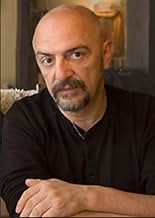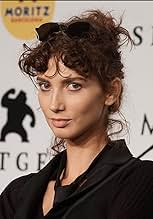CALIFICACIÓN DE IMDb
6.2/10
8.2 k
TU CALIFICACIÓN
Dos actrices, Béatrice Dalle y Charlotte Gainsbourg, llegan a un set de filmación para contar historias de brujas.Dos actrices, Béatrice Dalle y Charlotte Gainsbourg, llegan a un set de filmación para contar historias de brujas.Dos actrices, Béatrice Dalle y Charlotte Gainsbourg, llegan a un set de filmación para contar historias de brujas.
- Dirección
- Guionista
- Elenco
- Premios
- 1 nominación en total
- Dirección
- Guionista
- Todo el elenco y el equipo
- Producción, taquilla y más en IMDbPro
Opiniones destacadas
7 months after its premiere in Cannes (which I attended), I can't believe there is still no review of Lux Aeterna, so here is mine:
I think this film is admirable in many ways although not devoid of flaws, the main one being that for the nth time, Noé pulls the same expectable tricks with colorful lighting, flickering images and references to his classics (even just the title, "Lux Aeterna" is the György Ligeti eerie choir piece used in "2001: A Space Odyssey"), etc. So that does get a little unimaginative, especially since the atmosphere and development are very close to his latest long feature, "Climax".
That said, everything else is interesting. From the Dalle / Gainsbourg improvised dialogue (made hilarious by Dalle's very personal way of saying things - let's hope that won't get lost in translation) to the creative ways in which Noé uses the screen space. I couldn't stress this enough: *This Must Be Watched In A Movie Theater* ! Although I do enjoy smaller screens, I'm afraid a small screen won't cut it with this one. As usual with Noé, the experimental elements are present and the big screen is a must in order to enjoy them fully.
Many references are made throughout the film to Carl Dreyer's classic "Vredens Dag" from 1943, also using footage from it. It does serve a purpose but cannot really be discussed without spoiling.
I believe many interpretations of the film are possible. From mysogynistic to feminist. I'm definitely going with the latter. The end scene is intense in symbolism, deafening sound, flickering visuals and a creative use of the screen. If you suffer from epilepsy: STAY AWAY. As usual, Noé tries our patience and is into trying to shock us - but that's getting a bit old. Nothing gory though, so the faint of heart can watch. The camera flies from room to room as the crescendo builds up progressively until smothering hysteria. The film only lasts 50mn but it wouldn't necessarily have made more sense to make it any longer.
This is also definitely a film about film-making and how things go, on and off set. It's a film about actresses - how some can impose their strength or choose to go with what is asked of them.
This film will divide. Some will see it as arty, vaccuous and pointless. Others will find depth and meaning in it, but not necessarily the same meaning. I believe this is the best Noé film in a long time. Overall better than "Climax" or "Love". If you can get past Noé's antics, it is not only enjoyable, it is mostly an undeniable breath of fresh air in contemporary cinema.
I think this film is admirable in many ways although not devoid of flaws, the main one being that for the nth time, Noé pulls the same expectable tricks with colorful lighting, flickering images and references to his classics (even just the title, "Lux Aeterna" is the György Ligeti eerie choir piece used in "2001: A Space Odyssey"), etc. So that does get a little unimaginative, especially since the atmosphere and development are very close to his latest long feature, "Climax".
That said, everything else is interesting. From the Dalle / Gainsbourg improvised dialogue (made hilarious by Dalle's very personal way of saying things - let's hope that won't get lost in translation) to the creative ways in which Noé uses the screen space. I couldn't stress this enough: *This Must Be Watched In A Movie Theater* ! Although I do enjoy smaller screens, I'm afraid a small screen won't cut it with this one. As usual with Noé, the experimental elements are present and the big screen is a must in order to enjoy them fully.
Many references are made throughout the film to Carl Dreyer's classic "Vredens Dag" from 1943, also using footage from it. It does serve a purpose but cannot really be discussed without spoiling.
I believe many interpretations of the film are possible. From mysogynistic to feminist. I'm definitely going with the latter. The end scene is intense in symbolism, deafening sound, flickering visuals and a creative use of the screen. If you suffer from epilepsy: STAY AWAY. As usual, Noé tries our patience and is into trying to shock us - but that's getting a bit old. Nothing gory though, so the faint of heart can watch. The camera flies from room to room as the crescendo builds up progressively until smothering hysteria. The film only lasts 50mn but it wouldn't necessarily have made more sense to make it any longer.
This is also definitely a film about film-making and how things go, on and off set. It's a film about actresses - how some can impose their strength or choose to go with what is asked of them.
This film will divide. Some will see it as arty, vaccuous and pointless. Others will find depth and meaning in it, but not necessarily the same meaning. I believe this is the best Noé film in a long time. Overall better than "Climax" or "Love". If you can get past Noé's antics, it is not only enjoyable, it is mostly an undeniable breath of fresh air in contemporary cinema.
Even with this short runtime, the movie is stressful work, its overly pretentious, nearly a self-parody. The last minutes are just suffering for viewers and characters. Its bland and overly symbolic, does not create any character arc, every one of the characters is just a cut out paper, not even two dimensional. L'art pour l'art, right? But in this case, its just artificial. Meaningless. And the worst: It does not entertain. Not one moment.
... though it may just get you twitching.
A number of patients in a high security psychiatric hospital decide to make a short film. Conscious of the fact that in medieval times they would most likely have been considered witches or warlocks, since their behaviour could only be interpreted as such during those times, they place the punishment for such behaviour at the centre of their creation.
Fortunately, as luck would have it, the split screen personality allows the viewer to gorge on twice as much pagan pantomime than would normally be recommend but, since this piece occupies slightly less than an hour, they just about get away with it, although that may depend on the medication you're currently prescribed.
You'll be pleased when the credits role, although it's unlikely you'll make it through to the end.
A number of patients in a high security psychiatric hospital decide to make a short film. Conscious of the fact that in medieval times they would most likely have been considered witches or warlocks, since their behaviour could only be interpreted as such during those times, they place the punishment for such behaviour at the centre of their creation.
Fortunately, as luck would have it, the split screen personality allows the viewer to gorge on twice as much pagan pantomime than would normally be recommend but, since this piece occupies slightly less than an hour, they just about get away with it, although that may depend on the medication you're currently prescribed.
You'll be pleased when the credits role, although it's unlikely you'll make it through to the end.
Possibly the film in which Gaspar Noé most clearly shows his concept of cinema. The shooting is hell, even more than the staging. The need to challenge the comfort of the viewer (in the images and in the narration) is again present, in the different points of view. His vision surrounds the campaign of a fashion brand with mystery, which continues with the short film "Summer of '21" (2020), starring Charlotte Rampling. Only a director like Gaspar Noé can turn witches into Yves Saint Laurent models. "Sexocide: the genocide of the witches".
As a fan of Gaspar Noé, I enjoy his movies even when I feel sick of what I see in his movies. I'm also pretty sure that the most catchy element of his movies is the visuals. So far, i've seen his every feature films except Love. Climax, Irreversible and Enter the Void, which are mostly the favorites of the audience, achieved giving fancy visuals. Strangely, visuals of Lux Aeterna does not make you satisfied since the story leads to literally nowhere worthy. Instead, this time Gaspar Noé tries to introduce a point of view to role of woman in film industry and also in history. I can say that he does it well. Lux Aeterna is a "must watch" for Noé fans because in every second you will feel the style of Gaspar Noé. But if you are not a fan, this movie is a pure boredom and agony.
¿Sabías que…?
- TriviaParamedics were waiting outside of the premier at Cannes Film Festival, in case audience members would become sick or faint during the screening.
- Créditos curiososThe end credits were stylized Latin script used in the Middle Ages (e.g. with the letter "v" instead of "u") - This is how the title itself is written: Lvx Æterna. All the actor names included first names only, no family names. As the director himself said, in the times when Latin language was used, people didn't use surnames (family names), so he decided to put only first names in the end credits.
- ConexionesFeatures Häxan (1922)
Selecciones populares
Inicia sesión para calificar y agrega a la lista de videos para obtener recomendaciones personalizadas
- How long is Lux Æterna?Con tecnología de Alexa
Detalles
Taquilla
- Total en EE. UU. y Canadá
- USD 50,027
- Fin de semana de estreno en EE. UU. y Canadá
- USD 8,945
- 8 may 2022
- Total a nivel mundial
- USD 323,829
- Tiempo de ejecución51 minutos
- Color
- Relación de aspecto
- 1.33 : 1
- 2.35 : 1
Contribuir a esta página
Sugiere una edición o agrega el contenido que falta



![Bande-annonce [OV]](https://m.media-amazon.com/images/M/MV5BMWM2MzRmZmUtY2YxYy00ZTNhLTkwMDgtYWM0NDA0NDlhMDQzXkEyXkFqcGdeQXRyYW5zY29kZS13b3JrZmxvdw@@._V1_QL75_UX500_CR0)
































